Contents
Pluteus romellii
- Division: Basidiomycota (Basidiomycetes)
- Subdivision: Agaricomycotina (Agaricomycetes)
- Class: Agaricomycetes (Agaricomycetes)
- Subclass: Agaricomycetidae (Agaricomycetes)
- Order: Agaricales (Agaric or Lamellar)
- Family: Pluteaceae (Pluteaceae)
- Genus: Pluteus (Pluteus)
- Type: Pluteus romellii (Pluteus Romell)
:
- Plyutey bright
- Plutey yellowish
- Pluteus nanus var. shining
- A shiny plate
- Pluteus dwarf sp. lutescens
- Pluteus nanus ssp. shining
- A splendid shelf

The current name is Pluteus romellii (Britzelm.) Sacc.
The name is given in honor of the Swedish mycologist Lars Romell (1854-1927)
head small with a diameter of about 2-4 cm from wide-conical, semi-circular to flat-convex prostrate. A small, broad, blunt tubercle in the center often remains. The surface is smooth wrinkled with thin veins forming a radial-venous pattern that reaches the cap margin. The edge itself is often serrated, furrowed. In adult specimens, the cap may crack radially.
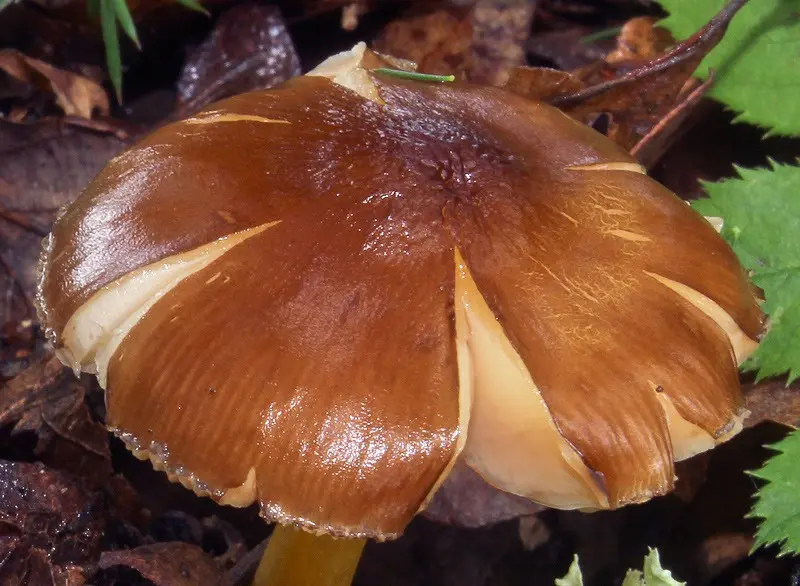
The surface color of the cap varies from honey-yellow, yellow-brown, brown to dark brown, brown. The flesh of the cap is thin-fleshed, fragile, whitish in color, does not change color on the cut. Taste and smell are neutral, not pronounced.
Hymenophore mushroom – lamellar. The plates are free, medium wide (up to 5 mm), moderately frequent with plates of different lengths. The color of the plates in young mushrooms is whitish, pale yellow, then, when ripe, acquires a beautiful dark pink hue.
spore print pink.

Microscopy
Spores are pink 6,1-6,6 × 5,4-6,2 microns; average 6,2 × 5,8 µm, shape from spherical to broadly ellipsoid, smooth, with a clear apex.
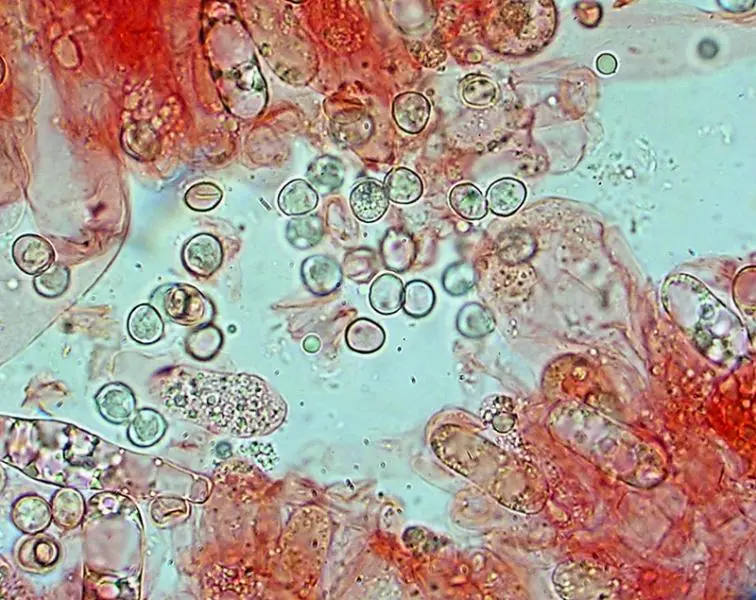
Basidia 24,1-33,9 × 7,6-9,6 µm, club-shaped, 4-spored, thin-walled, colorless.
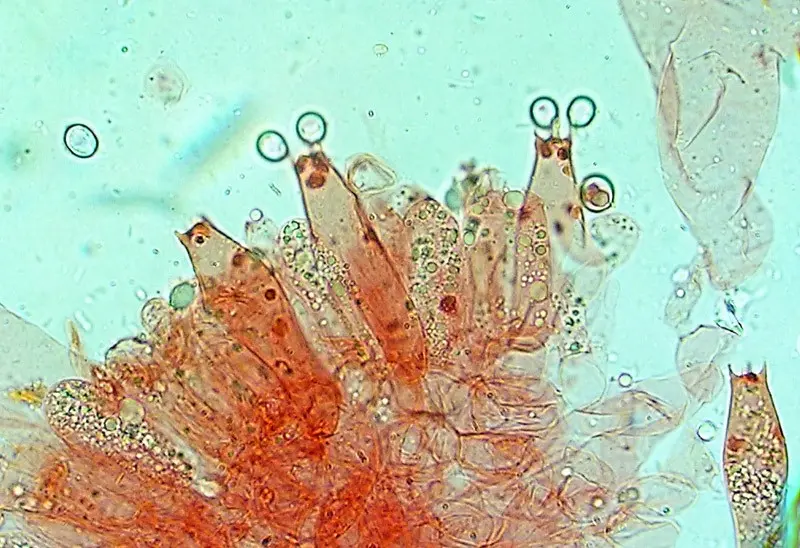
Cheilocystidia very numerous, pear-shaped, strictly to broadly club-shaped, some lobed, 31,1-69,4 × 13,9-32,5 µm.

Pleurocystidia 52,9-81,3 × 27,1-54,8 µm, club-shaped, utriform-ovate, not very numerous, larger than cheilocystidia.
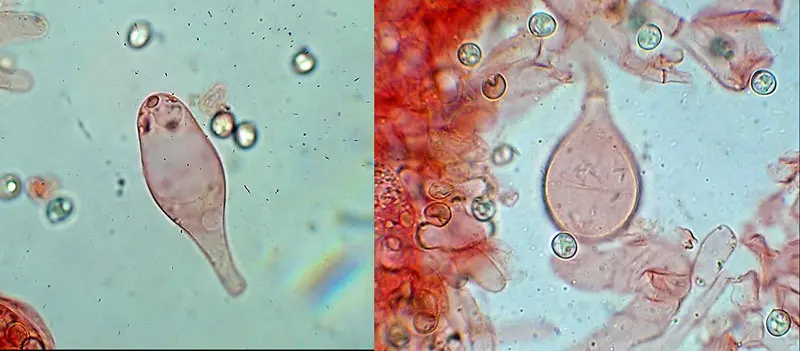
Pileipellis, 30–50 (60) × (10) 20–35 (45) µm, is formed by hymeniderm from club-shaped, spherical, and pear-shaped elements with intracellular brown pigment.
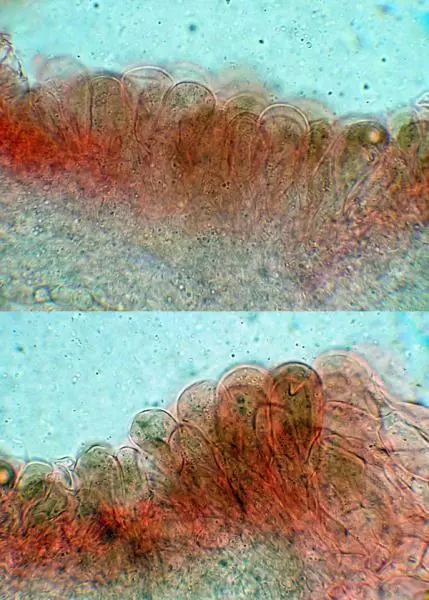
Leg central (sometimes it can be slightly eccentric) from 2 to 7 cm in length and up to 0,5 cm wide, cylindrical with a slight thickening towards the base, smooth, shiny, longitudinally fibrous. The surface is lemon yellow, the cap is slightly lighter. Rarely there are specimens with a light-colored stem up to almost white, in which case it becomes much more difficult to recognize the species.
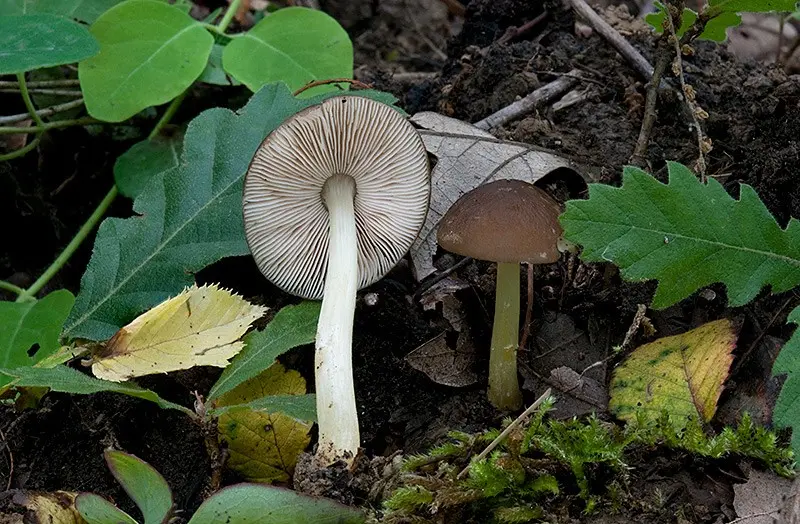
Plyutei Romell – saprotroph on stumps, dead wood or on the trunks of various deciduous trees that have fallen to the ground, buried woody remains. It was found on the wood of oak, hornbeam, alder, birch, white poplar, elm, hazel, plum, ash, hazel, chestnut, maple, Robinia. The distribution area is quite extensive, found in Europe from the British Isles, the Apennine Peninsula to the European part of Our Country. In Our Country, it was also found in Siberia, Primorsky Krai. It grows infrequently, singly and in small groups. Fruiting season: June – November.
There is no information about toxicity, but the mushroom is considered inedible.
Field identification of this fungus is usually easy due to the combination of brown cap and yellow stem.
It has a certain resemblance to some species of the genus of whips, which have yellowish and brownish variations:

Lion-yellow whip (Pluteus leoninus)
It differs in color (lack of brownish tones) and texture (velvety) of the cap and microscopic features.

Golden-colored whip (Pluteus chrysophaeus)
It is painted in yellowish color in contrast to p. Romell, in the color of the cap of which brown tones predominate.
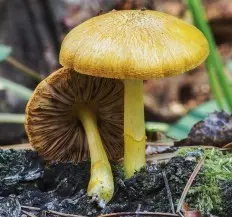
Fenzl’s Pluteus (Pluteus fenzlii)
This rare species is unmistakably identified by the ring on the stem.
Pluteus nanus (Pers.) P. Kumm. easy to distinguish by a smooth, shiny whitish stem, acquiring a brownish tint with age.
Photo used in the article: Vitaliy Gumenyuk, funghiitaliani.it.









